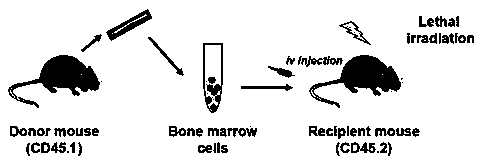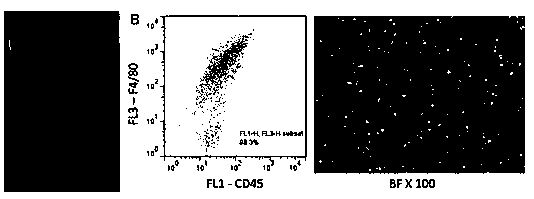Separation method for hepatic inherent and infiltrating macrophages
A technology of macrophages and separation method, which is applied in the field of separation of resident and infiltrating macrophages in the liver, and can solve the problems of inability to accurately distinguish the source of macrophages, lack of surface markers of liver infiltration and resident macrophages, etc.
- Summary
- Abstract
- Description
- Claims
- Application Information
AI Technical Summary
Problems solved by technology
Method used
Image
Examples
Embodiment Construction
[0060] In order to make the technical problems, technical solutions and advantages to be solved by the present invention clearer, the following will describe in detail with reference to the drawings and specific embodiments.
[0061] The present invention provides a method for separating liver intrinsic and infiltrating macrophages, comprising the following steps:
[0062] (1) Establish and identify a mouse allogeneic bone marrow transplantation model (such as figure 1 shown), the recipient mouse monocyte-macrophage surface marker is CD45.2, and the donor mouse monocyte-macrophage surface marker is CD45.1; the specific steps include:
[0063] a. Preparation of CD45.1 C57BL / 6 mouse bone marrow cells:
[0064] Sacrifice the mice and disinfect the skin;
[0065] The long bones of mouse limbs were freed and soaked in RPMI-1640;
[0066] Cut off the cartilage at both ends and flush out the cells in the bone marrow cavity;
[0067] Repeatedly blow and beat to mix the cel...
PUM
 Login to View More
Login to View More Abstract
Description
Claims
Application Information
 Login to View More
Login to View More - R&D
- Intellectual Property
- Life Sciences
- Materials
- Tech Scout
- Unparalleled Data Quality
- Higher Quality Content
- 60% Fewer Hallucinations
Browse by: Latest US Patents, China's latest patents, Technical Efficacy Thesaurus, Application Domain, Technology Topic, Popular Technical Reports.
© 2025 PatSnap. All rights reserved.Legal|Privacy policy|Modern Slavery Act Transparency Statement|Sitemap|About US| Contact US: help@patsnap.com



